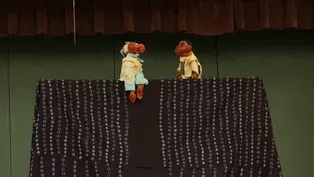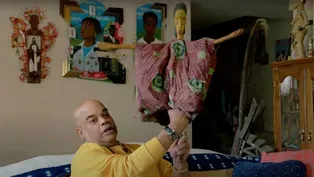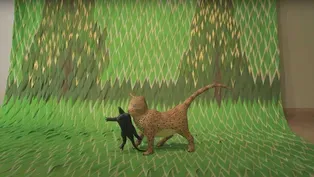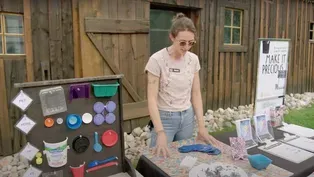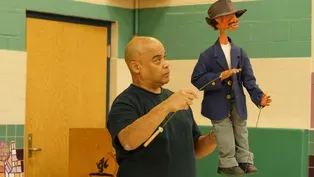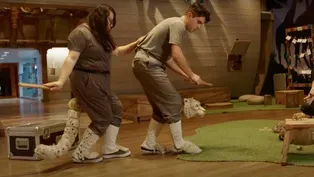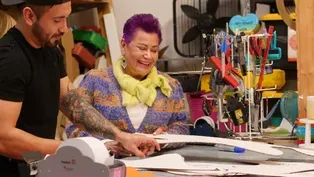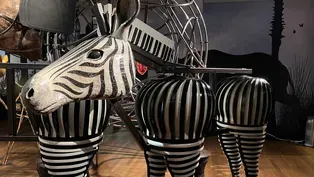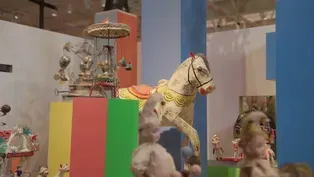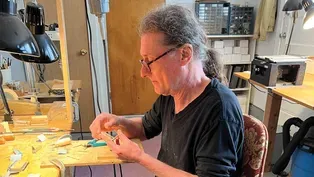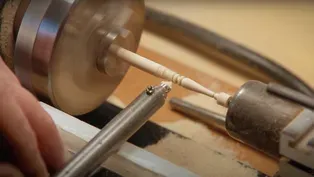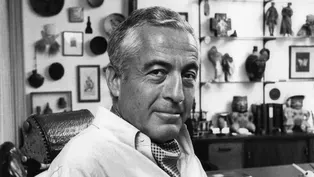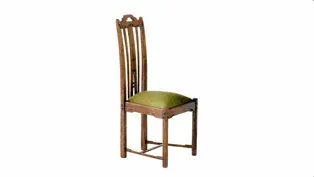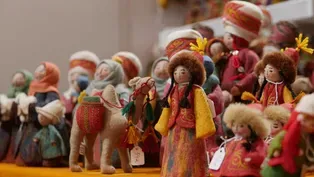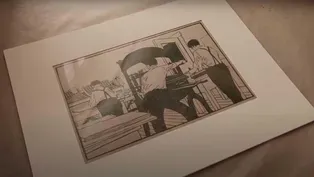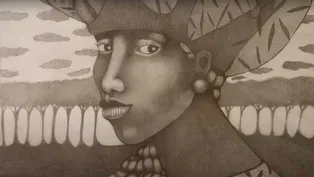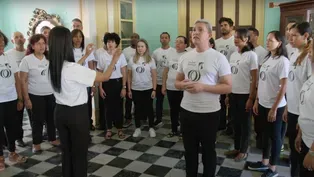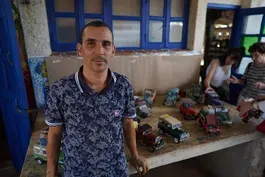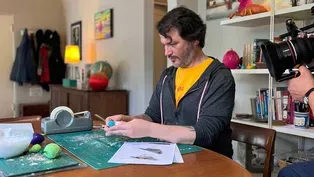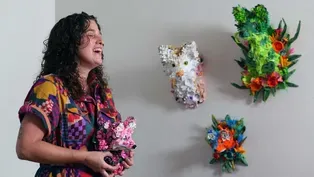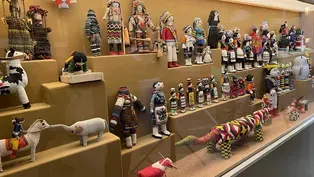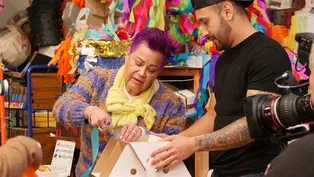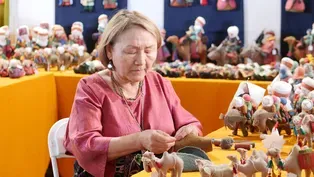
Noah's Ark at the Skirball segment
Clip: Season 15 | 12m 10sVideo has Closed Captions
Noah's Ark animals made using repurposed materials & Skirball's puppet fest
The Skirball Cultural Center is a Jewish educational institution that hosts a puppet festival annually. This year, artist Chris Green joins to revisit one of the centerpieces of their children’s programming, Noah’s Ark, a vast installation featuring hundreds of animals crafted from repurposed objects. Segment from the PLAY episode
Problems with Closed Captions? Closed Captioning Feedback
Problems with Closed Captions? Closed Captioning Feedback

Noah's Ark at the Skirball segment
Clip: Season 15 | 12m 10sVideo has Closed Captions
The Skirball Cultural Center is a Jewish educational institution that hosts a puppet festival annually. This year, artist Chris Green joins to revisit one of the centerpieces of their children’s programming, Noah’s Ark, a vast installation featuring hundreds of animals crafted from repurposed objects. Segment from the PLAY episode
Problems with Closed Captions? Closed Captioning Feedback
How to Watch Craft in America
Craft in America is available to stream on pbs.org and the free PBS App, available on iPhone, Apple TV, Android TV, Android smartphones, Amazon Fire TV, Amazon Fire Tablet, Roku, Samsung Smart TV, and Vizio.
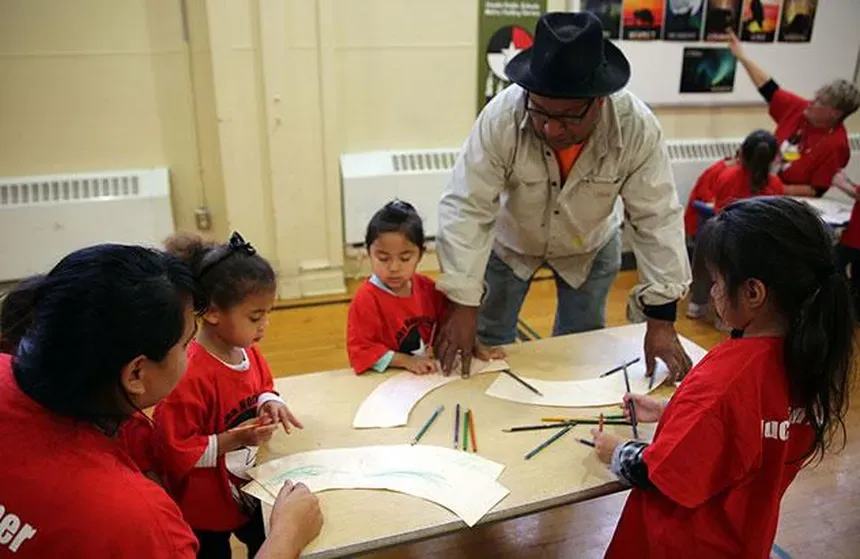
Education Guides
Download Craft in America education guides that educate, involve, and inform students about how craft plays a role in their lives, with connections to American history and culture, philosophies and science, social causes and social action.Providing Support for PBS.org
Learn Moreabout PBS online sponsorship♪♪ Jessie: The Skirball is a place of gathering inspired by this ancient Jewish idea that we could welcome the stranger.
Our founder Uri Herscher imagined this place when it was vacant land and the idea of a nontheological Jewish cultural center was utterly new.
♪♪ This is a place where, we hope, beauty and joy create that sense of safety that allows you to open yourself up to something that might be really different.
♪♪ Uri Herscher said he wanted for the Skirball to be one good place for everyone, and over and over again, we find art and culture is a way to provide that.
Sheri: Uri was thinking about what would be the best theme to engage a broad audience and be relevant and familiar.
Lloyd Cotsen, who was a beloved board member of the Skirball, happened to have one of the largest collections of folk-art Noah's Arks in existence.
Uri loved the fact that the Noah's Ark story had roots in the Hebrew Bible and that it had a presence in so many different cultures.
[Thunder] Nina: Noah's Ark at the Skirball is an 8,000-square-foot experience, and it tells the story of animals and people who survive a stormy time by getting onto a great, big ark and working together.
You come in, and you begin to realize that it's really you who gets to bring this story to life.
Man: OK. Everybody take one part of the zebra.
Here's one.
On three, we're gonna spin the zebra.
Ready?
one--push it this way--two, three... and look how fast they move as these zebras are running and running out from the storm.
Great job.
Nina: All the animals are on the go, and they're trying to find a safe place.
[Coyote howls] Sheri: It's the coyote who tells you when it's going to rain.
[Thunder] Boy: Go crazy.
Nina: Then you find yourself in the storm.
[Wind howling] It's on the visitor to create the storm.
Boy: There it is.
I can't believe it.
Whoo!
Nina: There are levers that you can push, and there are wheels to turn... and then it's time to get on board the ark.
The animals are all two by two.
♪♪ and it's their first day on the ark.
They're maybe kind of shy, and they're sticking with each other.
You can look up in the rafters and notice what other animals are here with you.
Sheri: We included bats and spiders, sloths, because life isn't only about the pandas and the kitty cats of the world.
We really welcomed that playfulness and difference.
♪♪ The team of people who worked on Noah's Ark included staff members, and we had sound specialists, movement artists, and folklorists, a host of creative partners.
♪♪ Chris: My role was to design and fabricate 46 life-sized, kinetic animals as well as puppets.
We knew that the animals were going to be comprised of repurposed materials.
That was sort of the key impetus for bringing me on, because I'd had all this history with creating work out of found objects.
♪♪ Sheri: What is important in this story of a flood?
When we were unpacking the meaning of it, this idea of second chances kept coming up, so the use of found objects that had had different purposes in the past was a way of kind of embodying the notion of second chances.
That was very important, as was the idea that it's so valuable to learn from the past and to honor memory.
Chris: Look at these antlers.
These are actual, you know, of course, pitchforks, and they're super sharp.
Anybody else would have said, "You know what?
Let's just nix this.
We'll make this out of rubber," but this team said, "Nope.
The point of this is that you're looking at an actual antique pitchfork."
Sheri: We wanted to create something that maybe didn't spell out every single feather and claw but would ignite children's imagination and allowed them to kind of fill in with their own powers of deduction.
Child: Hey foxy.
Here, a banana.
Ha ha ha!
Ha ha!
Rachel: Chris Green's puppets really invite the imagination, wonder, play.
Kids learn about problem solving and learn about themselves and the world around them through play.
Child: Here, foxy.
Different child: Oh, my.
Child: Here, little foxy.
Here.
You could help me.
Chris: The most important thing is the sense of eye contact-- "I see you.
You see me"-- so the idea of the animal puppets, heads being found objects, we didn't gravitate to that, and I was fortunate to have master builder Eric Novak, who, just by hand, carved the heads out of solid blocks of wood.
That's a major part of how, I think, we attempted to retain the majesty of the animals, was within the faces.
Sheri: That was such an important decision.
The eyes were so relatable on an emotional level, they really felt like they had kind of a spirit.
Chris: These were all fabricated in 2006, so after many years, I'm back to look at these things.
This is a chance to sort of keep them on their feet and active as long as possible.
The repair on this guy, this cockscomb, it's very fragile at this point.
I mean, as it as it is a hot water bottle, this is the original hot water bottle.
Michael: We throw nothing away, Chris.
We throw nothing away.
Chris: You guys are doing an amazing job with conservatorship and nothing loose.
This is a little loose.
So this is the right leg of the ostrich.
Yeah.
We used ax handles and with motorcycle gas tank covers representing the quad of the animal.
Michael: OK.
Here's the tail.
Chris: The elephant has two main components.
Michael: What are these?
These are sepak takraw balls, like volleyball but you use your feet, from Thailand.
Michael: I've seen that trunk come very close to some very delighted children.
[Elephant trumpets] Man: You want a strawberry?
Here you are.
Yum yum yum yum yum yum yum.
Nina: Time has gone by the further into the ark that you go.
Man: Would you like a banana?
[Elephant trumpets] Man: I will give it to the gorilla.
I sure will.
Nina: You come to the place that we call the Arkade.
That's where all the action is happening.
You can have climbing opportunities.
There is a baby nursery.
♪♪ It's really a fun place to work together.
Man: OK.
I'll start sweeping it your way.
There you are.
Rachel: Young people love to be helpers, and so our educators invite them to take care of an animal, feeding them or cleaning up after them.
♪♪ Jessie: When they first board the boat, these creatures just stay with those they know, and as you make your way through the story and the ark, you see all kinds of species intermingling in ways we might not expect had they not been stuck on this boat together, and that's what building community looks like.
♪♪ Nina: And then slowly the sounds of the rain have drifted out, and you peer off the ark and out into the new land, and there's a beautiful rainbow... Child: Look at these-- llama, polar bear.
Nina: so you're Noah in this story.
You get to do all the good deeds, taking care of each other and our environment.
[Shakers rattling] Sheri: We saw Noah's Ark as a story where the animals are really analogs for all the different people and communities of the world.
[Shakers rattling] Jessie: We are better through the storm together.
That's the story we take from ancient texts, and it feels relevant generation after generation.
♪♪ The Skirball has an annual puppet festival to showcase the different forms and artistry of puppetry.
♪♪ It's just a joyful day for not just the puppetry that happens inside of Noah's Ark, but we have various different styles of puppetry from different parts of the world.
♪♪ Chris: Play is actually serious business.
If you allow yourself to play, interact, and be open to the feedback that you have with the puppet, you're having a transformational experience yourself.
That's the goal.
♪♪ Rachel: I think the thing that I love the most about the puppet festival is our elephant... ♪♪ and to see the look on little kids' faces, to see, "What is that thing made of?
How does it move?"
♪♪ It's inviting that wonder and sparking that curiosity and that moment of awe.
♪♪
Woodblock print & marionette maker Gustave Baumann segment
Video has Closed Captions
Multidisciplinary artist, Gustave Baumann, was deeply inspired by Santa Fe (12m 16s)
Underground Railroad, Not a Subway by Schroeder Cherry
Video has Closed Captions
Schroeder Cherry's puppetry performance, Underground Railroad, Not a Subway (25m 34s)
Schroeder Cherry's Civil Rights Childrens Crusade
Video has Closed Captions
Schroeder Cherry's puppetry performance, Civil Rights Childrens Crusade (9m 53s)
Schroeder Cherry's African Puppets
Video has Closed Captions
Artist, puppeteer, museum educator Schroeder Cherry on African puppets in his collection (2m 36s)
Roberto Benavidez on creating piñatas & "piñathkos"
Video has Closed Captions
Artist Roberto Benavidez speaks with curator and art historian on his piñatas & piñathkos (1m 49s)
Recycling plastic through Precious Plastic program
Video has Closed Captions
Sustainability coordinator on recycling plastic through their Precious Plastic program (54s)
Puppeteer Schroeder Cherry segment
Video has Closed Captions
How puppets can become vehicles of history & change: the work of Schroeder Cherry (10m 29s)
Puppeteering the snow leopard at Noah's Ark
Video has Closed Captions
Kinetic designer Chris Green works with Noah's Ark educators on puppeteering snow leopard (1m 47s)
Piñata maker Lorena Robletto segment
Video has Closed Captions
Lorena Robletto creates festive and creative piñatas with fair labor practices at her business, Amaz (6m 14s)
Noah's Ark at the Skirball segment
Video has Closed Captions
Noah's Ark animals made using repurposed materials & Skirball's puppet fest (12m 10s)
Multiple Visions: A Common Bond
Video has Closed Captions
Alexander Girard's folk art collection at Museum of International Folk Art Museum (1m 20s)
Miniaturist Mark Murphy segment
Video has Closed Captions
Woodworker makes tiny furniture: Meet miniaturist Mark Murphy (10m 31s)
Mark Murphy shows us his miniature furniture
Video has Closed Captions
Miniaturist Mark Murphy shows us his miniature 1/12th scale furniture (2m 19s)
Lloyd Cotsen & the Cotsen Children's Library segment
Video has Closed Captions
Lloyd Cotsen founded the Cotsen Children’s Library at Princeton University (5m 45s)
Video has Closed Captions
Lloyd Cotsen's collection of Chinese bronze mirrors, textiles, folk art, Japanese baskets (5m 22s)
International Guild of Miniature Artisans
Video has Closed Captions
Barbara Davis on the International Guild of Miniature Artisans and their Guild School (2m 27s)
International Folk Art Market segment
Video has Closed Captions
Meet artisans at the International Folk Art Market (9m 5s)
International Folk Art Market basket weaver
Video has Closed Captions
Master basket weaver Nelsiwe Dlamini at International Folk Art Market (1m 57s)
Gustave Baumann's Printing the Democrat woodblock print
Video has Closed Captions
Thomas Leech on Gustave Baumann's woodblock print, The Print Shop/Printing the Democrat (1m 10s)
Video has Closed Captions
JELMA curator Schroeder Cherry invites artist Espi Frazier to show her work in the gallery (1m 16s)
El Orfeon Santiago Chorus performance - bonus video from MINIATURES (1m 23s)
Cuban artist Leandro Gómez Quintero segment
Video has Closed Captions
Small scale model cars by Cuban artist Leandro Gómez Quintero (13m 43s)
Calder Kamin on Austin Creative Reuse
Video has Closed Captions
Artist Calder Kamin on how she discovered Austin Creative Reuse (1m 18s)
Artist Roberto Benavidez segment
Video has Closed Captions
Roberto Benavidez's piñatas inspired by medieval manuscripts (8m 24s)
Video has Closed Captions
Calder Kamin creates an art installation by reusing and recycling discarded plastic (10m 6s)
Alexander Girard's miniature folk art collection segment
Video has Closed Captions
Alexander Girard's miniature folk art collection hopes to evoke common humanity. (8m 6s)
Video has Closed Captions
Watch a preview of PLAY, streaming Dec 1, broadcast premiere Dec 29 (1m)
Video has Closed Captions
Watch a preview of MINIATURES, streaming Dec 1, PBS broadcast premiere Dec 29 (1m)
Providing Support for PBS.org
Learn Moreabout PBS online sponsorshipSupport for PBS provided by:

